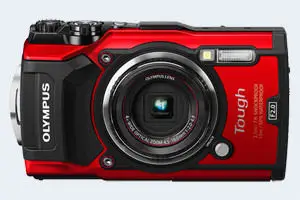Canon XC10 vs Olympus TG-5
The Canon XC10 and the Olympus Tough TG-5 are two digital cameras that were revealed to the public, respectively, in April 2015 and May 2017. Both the XC10 and the TG-5 are fixed lens compact cameras that are based on an one-inch (XC10) and a 1/2.3-inch (TG-5) sensor. Both cameras offer a resolution of 12 megapixels.
Below is an overview of the main specs of the two cameras as a starting point for the comparison.

Check XC10 offers at
ebay.com

Check TG-5 offers at
ebay.com
Going beyond this snapshot of core features and characteristics, what are the differences between the Canon XC10 and the Olympus Tough TG-5? Which one should you buy? Read on to find out how these two cameras compare with respect to their body size, their imaging sensors, their shooting features, their input-output connections, and their reception by expert reviewers.
Body comparison
The side-by-side display below illustrates the physical size and weight of the Canon XC10 and the Olympus TG-5. The two cameras are presented according to their relative size. Three successive views from the front, the top, and the rear are shown. All width, height and depth dimensions are rounded to the nearest millimeter.
The TG-5 can be obtained in two different colors (black, red), while the XC10 is only available in black.
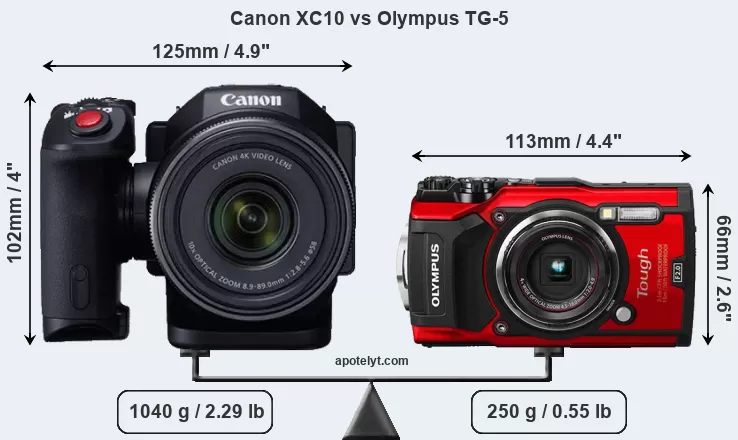
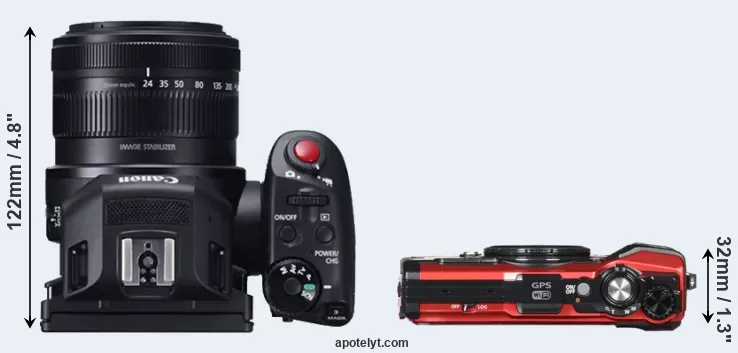
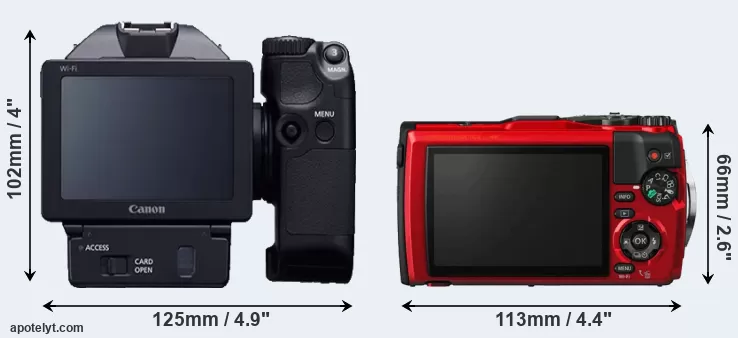
If the front view area (width x height) of the cameras is taken as an aggregate measure of their size, the Olympus TG-5 is considerably smaller (42 percent) than the Canon XC10. Moreover, the TG-5 is substantially lighter (76 percent) than the XC10. It is noteworthy in this context that the TG-5 is splash and dust-proof, while the XC10 does not feature any corresponding weather-sealing. More than that, the TG-5 is water-proof up to 15m and can, thus, be used for underwater photography.
Concerning battery life, the XC10 gets 370 shots out of its Canon LP-E6N battery, while the TG-5 can take 340 images on a single charge of its Olympus LI-92B power pack. The battery packs of both cameras can be charged via USB, which can be very convenient when travelling.
The following table provides a synthesis of the main physical specifications of the two cameras and other similar ones. If you would like to visualize and compare a different camera combination, you can navigate to the CAM-parator app and make your selection from a broad list of cameras there.

| Camera Model |
Camera Width |
Camera Height |
Camera Depth |
Camera Weight |
Battery Life |
Weather Sealing |
Camera Launch |
Launch Price (USD) |
Street Price |
||
|---|---|---|---|---|---|---|---|---|---|---|---|
| 1. | Canon XC10 | 125 mm | 102 mm | 122 mm | 1040 g | 370 | n | Apr 2015 | 2,499 | ebay.com | |
| 2. | Olympus TG-5 | 113 mm | 66 mm | 32 mm | 250 g | 340 | Y | May 2017 | 449 | ebay.com | |
| 3. | Canon G1 X Mark II | 116 mm | 74 mm | 66 mm | 553 g | 240 | n | Feb 2014 | 799 | ebay.com | |
| 4. | Canon G5 X | 112 mm | 76 mm | 44 mm | 353 g | 210 | n | Oct 2015 | 799 | ebay.com | |
| 5. | Canon G7 X | 103 mm | 60 mm | 40 mm | 304 g | 210 | n | Sep 2014 | 699 | ebay.com | |
| 6. | Canon G7 X Mark II | 106 mm | 61 mm | 42 mm | 319 g | 265 | n | Feb 2016 | 699 | ebay.com | |
| 7. | Canon G9 X | 98 mm | 58 mm | 31 mm | 209 g | 220 | n | Oct 2015 | 529 | ebay.com | |
| 8. | Canon SX60 | 128 mm | 93 mm | 114 mm | 650 g | 340 | n | Sep 2014 | 549 | ebay.com | |
| 9. | Canon SX730 | 110 mm | 64 mm | 40 mm | 300 g | 250 | n | Apr 2017 | 399 | ebay.com | |
| 10. | Fujifilm X30 | 119 mm | 72 mm | 60 mm | 423 g | 470 | n | Aug 2014 | 599 | ebay.com | |
| 11. | Nikon P900 | 140 mm | 103 mm | 137 mm | 899 g | 360 | n | Mar 2015 | 599 | ebay.com | |
| 12. | Olympus TG-4 | 112 mm | 66 mm | 31 mm | 247 g | 380 | Y | Apr 2015 | 379 | ebay.com | |
| 13. | Olympus TG-6 | 113 mm | 66 mm | 32 mm | 253 g | 340 | Y | May 2019 | 449 | ebay.com | |
| 14. | Olympus XZ-1 | 111 mm | 65 mm | 42 mm | 275 g | 320 | n | Jan 2011 | 499 | ebay.com | |
| 15. | OM System TG-7 | 114 mm | 66 mm | 33 mm | 249 g | 330 | Y | Sep 2023 | 549 | amazon.com | |
| 16. | Panasonic FZ2500 | 138 mm | 102 mm | 135 mm | 915 g | 350 | n | Sep 2016 | 1,199 | amazon.com | |
| 17. | Panasonic LX100 | 115 mm | 66 mm | 55 mm | 393 g | 300 | n | Sep 2014 | 899 | ebay.com | |
| Note: Measurements and pricing do not include easily detachable parts, such as add-on or interchangeable lenses or optional viewfinders. | |||||||||||
Any camera decision will naturally be influenced heavily by the price. The retail prices at the time of the camera’s release place the model in the market relative to other models in the producer’s line-up and the competition. The TG-5 was launched at a markedly lower price (by 82 percent) than the XC10, which puts it into a different market segment. Usually, retail prices stay at first close to the launch price, but after several months, discounts become available. Later in the product cycle and, in particular, when the replacement model is about to appear, further discounting and stock clearance sales often push the camera price considerably down. Then, after the new model is out, very good deals can frequently be found on the pre-owned market.
Sensor comparison
The imaging sensor is at the core of digital cameras and its size is one of the main determining factors of image quality. A large sensor will generally have larger individual pixels that offer better low-light sensitivity, provide wider dynamic range, and have richer color-depth than smaller pixels in a sensor of the same technological generation. Furthermore, a large sensor camera will give the photographer more possibilities to use shallow depth-of-field in order to isolate a subject from the background. On the downside, larger sensors are more costly to manufacture and tend to lead to bigger and heavier cameras and lenses.
Of the two cameras under consideration, the Canon XC10 features an one-inch sensor and the Olympus TG-5 a 1/2.3-inch sensor. The sensor area in the TG-5 is 77 percent smaller. As a result of these sensor size differences, the cameras have a format factor of, respectively, 2.75 and 5.6. Both cameras feature a native aspect ratio (sensor width to sensor height) of 4:3.
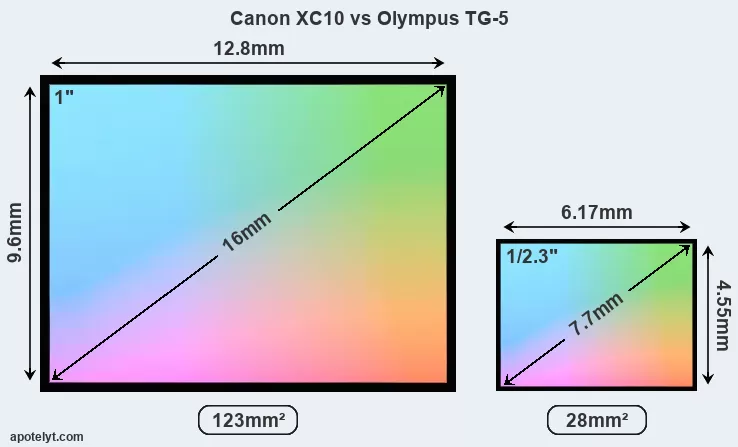
Even though the XC10 has a larger sensor, both cameras offer the same resolution of 12 megapixels. This implies that the XC10 has a lower pixel density and larger individual pixels (with a pixel pitch of 3.20μm versus 1.53μm for the TG-5), which gives it a potential advantage in terms of light gathering capacity. It should, however, be noted that the TG-5 is much more recent (by 2 years and 1 month) than the XC10, and its sensor will have benefitted from technological advances during this time that at least partly compensate for the smaller pixel size.
The Canon XC10 has a native sensitivity range from ISO 160 to ISO 20000. The corresponding ISO settings for the Olympus Tough TG-5 are ISO 100 to ISO 12800 (no boost).
In terms of underlying technology, the XC10 is build around a CMOS sensor, while the TG-5 uses a BSI-CMOS imager. Both cameras use a Bayer filter for capturing RGB colors on a square grid of photosensors. This arrangement is found in most digital cameras.
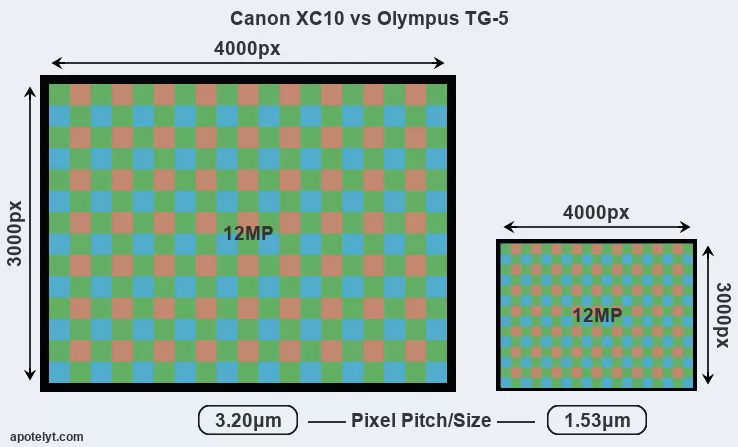
For many cameras, data on sensor performance has been reported by DXO Mark. This service assesses and scores the color depth ("DXO Portrait"), dynamic range ("DXO Landscape"), and low-light sensitivity ("DXO Sports") of camera sensors, and also publishes an overall camera score. The table below summarizes the physical sensor characteristics and sensor quality findings and compares them across a set of similar cameras.

| Camera Model |
Sensor Class |
Resolution (MP) |
Horiz. Pixels |
Vert. Pixels |
Video Format |
DXO Portrait |
DXO Landscape |
DXO Sports |
DXO Overall |
||
|---|---|---|---|---|---|---|---|---|---|---|---|
| 1. | Canon XC10 | 1-inch | 12.0 | 4000 | 3000 | 4K/30p | 21.7 | 11.8 | 197 | 61 | |
| 2. | Olympus TG-5 | 1/2.3 | 12.0 | 4000 | 3000 | 4K/30p | 20.5 | 11.9 | 934 | 50 | |
| 3. | Canon G1 X Mark II | 1.5-inch | 13.0 | 4160 | 3120 | 1080/30p | 21.5 | 10.8 | 581 | 58 | |
| 4. | Canon G5 X | 1-inch | 20.0 | 5472 | 3648 | 1080/60p | 21.4 | 12.3 | 471 | 62 | |
| 5. | Canon G7 X | 1-inch | 20.0 | 5472 | 3648 | 1080/60p | 23.0 | 12.7 | 556 | 71 | |
| 6. | Canon G7 X Mark II | 1-inch | 20.0 | 5472 | 3648 | 1080/60p | 21.8 | 11.9 | 260 | 62 | |
| 7. | Canon G9 X | 1-inch | 20.0 | 5472 | 3648 | 1080/60p | 21.5 | 12.3 | 495 | 63 | |
| 8. | Canon SX60 | 1/2.3 | 14.2 | 4608 | 3072 | 1080/60p | 19.2 | 10.8 | 127 | 39 | |
| 9. | Canon SX730 | 1/2.3 | 20.2 | 5184 | 3888 | 1080/60p | 20.5 | 11.9 | 924 | 50 | |
| 10. | Fujifilm X30 | 2/3 | 12.0 | 4000 | 3000 | 1080/60p | 20.4 | 11.2 | -312 | 49 | |
| 11. | Nikon P900 | 1/2.3 | 15.9 | 4608 | 3456 | 1080/60p | 20.2 | 11.6 | 727 | 47 | |
| 12. | Olympus TG-4 | 1/2.3 | 15.9 | 4608 | 3456 | 1080/30p | 20.2 | 11.6 | 737 | 47 | |
| 13. | Olympus TG-6 | 1/2.3 | 12.0 | 4000 | 3000 | 4K/30p | 20.7 | 12.2 | 1127 | 52 | |
| 14. | Olympus XZ-1 | 1/1.7 | 10.1 | 3664 | 2752 | 720/30p | 18.8 | 10.4 | 117 | 34 | |
| 15. | OM System TG-7 | 1/2.3 | 12.0 | 4000 | 3000 | 4K/30p | 20.9 | 12.7 | 1553 | 54 | |
| 16. | Panasonic FZ2500 | 1-inch | 20.0 | 5472 | 3648 | 4K/30p | 23.0 | 12.6 | 538 | 70 | |
| 17. | Panasonic LX100 | Four Thirds | 12.7 | 4112 | 3088 | 4K/30p | 22.3 | 12.5 | 553 | 67 | |
| Note: DXO values in italics represent estimates based on sensor size and age. | |||||||||||
Many modern cameras are not only capable of taking still images, but can also record movies. Both cameras under consideration have a sensor with sufficiently fast read-out times for moving pictures, and both provide the same movie specifications (4K/30p).
Feature comparison
Apart from body and sensor, cameras can and do differ across a variety of features. The XC10 and the TG-5 are similar in the sense that neither of the two has a viewfinder. The images are, thus, framed using live view on the rear LCD. The adjacent table lists some of the other core features of the Canon XC10 and Olympus TG-5 along with similar information for a selection of comparators.

| Camera Model |
Viewfinder (Type or 000 dots) |
Control Panel (yes/no) |
LCD Specifications (inch/000 dots) |
LCD Attach- ment |
Touch Screen (yes/no) |
Max Shutter Speed * |
Max Shutter Flaps * |
Built-in Flash (yes/no) |
Built-in Image Stab |
||
|---|---|---|---|---|---|---|---|---|---|---|---|
| 1. | Canon XC10 | none | n | 3.0 / 1030 | tilting | Y | 1/2000s | 3.8/s | n | Y | |
| 2. | Olympus TG-5 | none | n | 3.0 / 460 | fixed | n | 1/2000s | 20.0/s | Y | Y | |
| 3. | Canon G1 X Mark II | optional | n | 3.0 / 1040 | tilting | Y | 1/4000s | 5.2/s | Y | Y | |
| 4. | Canon G5 X | 2360 | n | 3.0 / 1040 | swivel | Y | 1/2000s | 5.9/s | Y | Y | |
| 5. | Canon G7 X | none | n | 3.0 / 1040 | tilting | Y | 1/2000s | 6.5/s | Y | Y | |
| 6. | Canon G7 X Mark II | none | n | 3.0 / 1040 | tilting | Y | 1/2000s | 8.0/s | Y | Y | |
| 7. | Canon G9 X | none | n | 3.0 / 1040 | fixed | Y | 1/2000s | 6.0/s | Y | Y | |
| 8. | Canon SX60 | 922 | n | 3.0 / 922 | swivel | n | 1/2000s | 6.4/s | Y | Y | |
| 9. | Canon SX730 | none | n | 3.0 / 922 | tilting | n | 1/3200s | 5.9/s | Y | Y | |
| 10. | Fujifilm X30 | 2360 | n | 3.0 / 920 | tilting | n | 1/4000s | 12.0/s | Y | Y | |
| 11. | Nikon P900 | 921 | n | 3.0 / 921 | swivel | n | 1/4000s | 7.0/s | Y | Y | |
| 12. | Olympus TG-4 | none | n | 3.0 / 460 | fixed | n | 1/2000s | 5.0/s | Y | Y | |
| 13. | Olympus TG-6 | none | n | 3.0 / 1040 | fixed | n | 1/2000s | 20.0/s | Y | Y | |
| 14. | Olympus XZ-1 | optional | n | 3.0 / 614 | fixed | n | 1/2000s | 2.0/s | Y | Y | |
| 15. | OM System TG-7 | none | n | 3.0 / 1040 | fixed | n | 1/2000s | 20.0/s | Y | Y | |
| 16. | Panasonic FZ2500 | 2360 | n | 3.0 / 1040 | swivel | Y | 1/4000s | 12.0/s | Y | Y | |
| 17. | Panasonic LX100 | 2764 | n | 3.0 / 921 | fixed | n | 1/4000s | 11.0/s | n | Y | |
| Note: *) Information refers to the mechanical shutter, unless the camera only has an electronic one. | |||||||||||
One differentiating feature between the two cameras concerns the touch sensitivity of the rear screen. The XC10 has a touchscreen, while the TG-5 has a conventional panel. Touch control can be particularly helpful, for example, for setting the focus point.
The Canon XC10 and the Olympus TG-5 both have an intervalometer built-in. This enables the photographer to capture time lapse sequences, such as flower blooming, a sunset or moon rise, without purchasing an external camera trigger and related software.
Both the XC10 and the TG-5 have zoom lenses built in. The XC10 has a 24-240mm f/2.8-5.6 optic and the TG-5 offers a 25-100mm f/2.0-4.9 (focal lengths in full frame equivalent terms). Hence, the Canon provides a wider angle of view at the short end, as well as more tele-photo reach at the long end than the Olympus. The TG-5 offers the faster maximum aperture.
The XC10 writes its imaging data to CFast or SDXC cards, while the TG-5 uses SDXC cards. The XC10 features dual card slots, which can be very useful in case a memory card fails. In contrast, the TG-5 only has one slot. Both cameras can use UHS-I cards, which provide for Ultra High Speed data transfer of up to 104 MB/s.
Connectivity comparison
For some imaging applications, the extent to which a camera can communicate with its environment can be an important aspect in the camera decision process. The table below provides an overview of the connectivity of the Canon XC10 and Olympus Tough TG-5 and, in particular, the interfaces the cameras (and selected comparators) provide for accessory control and data transfer.

| Camera Model |
Hotshoe Port |
Internal Mic / Speaker |
Microphone Port |
Headphone Port |
HDMI Port |
USB Port |
WiFi Support |
NFC Support |
Bluetooth Support |
||
|---|---|---|---|---|---|---|---|---|---|---|---|
| 1. | Canon XC10 | Y | stereo / mono | Y | Y | mini | 2.0 | Y | Y | - | |
| 2. | Olympus TG-5 | - | stereo / mono | - | - | micro | 2.0 | Y | - | - | |
| 3. | Canon G1 X Mark II | Y | stereo / mono | - | - | mini | 2.0 | Y | Y | - | |
| 4. | Canon G5 X | Y | stereo / mono | - | - | mini | 2.0 | Y | Y | - | |
| 5. | Canon G7 X | - | stereo / mono | - | - | micro | 2.0 | Y | Y | - | |
| 6. | Canon G7 X Mark II | - | stereo / mono | - | - | micro | 2.0 | Y | Y | - | |
| 7. | Canon G9 X | - | stereo / mono | - | - | micro | 2.0 | Y | Y | - | |
| 8. | Canon SX60 | Y | stereo / mono | Y | - | mini | 2.0 | Y | Y | - | |
| 9. | Canon SX730 | - | stereo / mono | - | - | micro | 2.0 | Y | Y | Y | |
| 10. | Fujifilm X30 | Y | stereo / mono | - | - | micro | 2.0 | Y | - | - | |
| 11. | Nikon P900 | - | stereo / mono | - | - | micro | 2.0 | Y | Y | - | |
| 12. | Olympus TG-4 | - | stereo / mono | - | - | micro | 2.0 | Y | - | - | |
| 13. | Olympus TG-6 | - | stereo / mono | - | - | micro | 2.0 | Y | - | - | |
| 14. | Olympus XZ-1 | Y | mono / - | - | - | mini | 2.0 | - | - | - | |
| 15. | OM System TG-7 | - | stereo / mono | - | - | micro | 2.0 | Y | - | - | |
| 16. | Panasonic FZ2500 | Y | stereo / mono | Y | Y | micro | 2.0 | Y | - | - | |
| 17. | Panasonic LX100 | Y | stereo / mono | - | - | micro | 2.0 | Y | Y | - |
It is notable that the XC10 has a hotshoe, while the TG-5 does not. This socket makes it possible to easily attach optional accessories, such as an external flash gun.
Travel and landscape photographers will find it useful that the TG-5 has an internal geolocalization sensor and can record GPS coordinates in its EXIF data.
Both the XC10 and the TG-5 have been discontinued, but can regularly be found used on ebay. The XC10 was replaced by the Canon XC15, while the TG-5 was followed by the Olympus TG-6. Further information on the features and operation of the XC10 and TG-5 can be found, respectively, in the Canon XC10 Manual (free pdf) or the online Olympus TG-5 Manual.
Review summary
So what is the bottom line? Is the Canon XC10 better than the Olympus TG-5 or vice versa? A synthesis of the relative strong points of each of the models is listed below.

Arguments in favor of the Canon XC10:
- Better image quality: Features bigger pixels on a larger sensor for higher quality imaging.
- Richer colors: The pixel size advantage translates into images with better, more accurate colors.
- More dynamic range: Larger pixels capture a wider spectrum of light and dark details.
- Better low-light sensitivity: Larger pixels means good image quality even under poor lighting.
- Better sound: Can connect to an external microphone for higher quality sound recording.
- Better sound control: Has a headphone port that enables audio monitoring while recording.
- More detailed LCD: Has a higher resolution rear screen (1030k vs 460k dots).
- More flexible LCD: Has a tilting screen for odd-angle shots in landscape orientation.
- Fewer buttons to press: Is equipped with a touch-sensitive rear screen to facilitate handling.
- Wider view: Has a wider-angle lens that facilitates landscape or interior shots.
- More tele-reach: Has a longer tele-lens for perspective compression and subject magnification.
- Better lighting: Features a hotshoe and can thus hold and trigger an external flash gun.
- Easier device pairing: Supports NFC for fast wireless image transfer over short distances.
- Greater peace of mind: Features a second card slot as a backup in case of memory card failure.
- More heavily discounted: Has been available for much longer (launched in April 2015).

Advantages of the Olympus Tough TG-5:
- Faster burst: Shoots at higher frequency (20 vs 3.8 flaps/sec) to capture the decisive moment.
- Better light gathering: Has a lens with a wider maximum aperture (f/2.0 vs f/2.8).
- More compact: Is smaller (113x66mm vs 125x102mm) and will fit more readily into a bag.
- Less heavy: Has a lower weight (by 790g or 76 percent) and is thus easier to take along.
- Better sealing: Is splash and dust sealed for shooting in inclement weather conditions.
- Water-proof: Is rugged and sealed and can thus be used for underwater photography (up to 15m).
- Easier fill-in: Has a small integrated flash to brighten shadows of backlit subjects.
- Easier geotagging: Features an internal GPS sensor to log localization data.
- More affordable: Was introduced into a lower priced category (82 percent cheaper at launch).
- More modern: Reflects 2 years and 1 month of technical progress since the XC10 launch.
If the count of relative strengths (bullet points above) is taken as a measure, the XC10 is the clear winner of the match-up (15 : 10 points). However, the relative importance of the various individual camera aspects will vary according to personal preferences and needs, so that you might like to apply corresponding weights to the particular features before making a decision on a new camera. A professional wildlife photographer will view the differences between cameras in a way that diverges from the perspective of a family photog, and a person interested in architecture has distinct needs from a sports shooter. Hence, the decision which camera is best and worth buying is often a very personal one.
How about other alternatives? Do the specifications of the Canon XC10 and the Olympus TG-5 place the cameras among the top in their class? Find out in the latest Best Superzoom Camera and Best Travel-Zoom Camera listings whether the two cameras rank among the cream of the crop.
In any case, while the comparison of technical specifications can provide a useful overview of the capabilities of different cameras, it remains incomplete and does no justice, for example, to the way the XC10 or the TG-5 perform in practice. At times, user reviews, such as those published at amazon, address these issues in a useful manner, but such feedback is on many occasions incomplete, inconsistent, and unreliable.
Expert reviews
This is why hands-on reviews by experts are important. The adjacent summary-table relays the overall verdicts of several of the most popular camera review sites (amateurphotographer [AP], cameralabs [CL], digitalcameraworld [DCW], dpreview [DPR], ephotozine [EPZ], photographyblog [PB]). As can be seen, the professional reviewers agree in many cases on the quality of different cameras, but sometimes their assessments diverge, reinforcing the earlier point that a camera decision is often a very personal choice.

| Camera Model |
AP score |
CL score |
DCW score |
DPR score |
EPZ score |
PB score |
Camera Launch |
Launch Price (USD) |
Street Price |
||
|---|---|---|---|---|---|---|---|---|---|---|---|
| 1. | Canon XC10 | .. | .. | .. | 80/100 | .. | .. | Apr 2015 | 2,499 | ebay.com | |
| 2. | Olympus TG-5 | .. | + + | 4.5/5 | .. | 4/5 | 4/5 | May 2017 | 449 | ebay.com | |
| 3. | Canon G1 X Mark II | 3/5 | + | .. | 77/100 | 4/5 | 4.5/5 | Feb 2014 | 799 | ebay.com | |
| 4. | Canon G5 X | 5/5 | + + | .. | 78/100 | 4.5/5 | 4.5/5 | Oct 2015 | 799 | ebay.com | |
| 5. | Canon G7 X | 4/5 | + + | .. | 77/100 | 4.5/5 | 4.5/5 | Sep 2014 | 699 | ebay.com | |
| 6. | Canon G7 X Mark II | 4.5/5 | + + | .. | 81/100 | 4.5/5 | 4.5/5 | Feb 2016 | 699 | ebay.com | |
| 7. | Canon G9 X | 3.5/5 | + + | .. | .. | 4.5/5 | 4.5/5 | Oct 2015 | 529 | ebay.com | |
| 8. | Canon SX60 | 3/5 | + + | .. | 75/100 | 4/5 | 4.5/5 | Sep 2014 | 549 | ebay.com | |
| 9. | Canon SX730 | .. | + | .. | .. | 4/5 | 4/5 | Apr 2017 | 399 | ebay.com | |
| 10. | Fujifilm X30 | 4/5 | .. | .. | 76/100 | 4.5/5 | 4.5/5 | Aug 2014 | 599 | ebay.com | |
| 11. | Nikon P900 | .. | .. | .. | 77/100 | 4/5 | 4/5 | Mar 2015 | 599 | ebay.com | |
| 12. | Olympus TG-4 | .. | + | .. | 79/100 | 4/5 | 4/5 | Apr 2015 | 379 | ebay.com | |
| 13. | Olympus TG-6 | 4/5 | + + | 4.5/5 | 76/100 | 4/5 | 4/5 | May 2019 | 449 | ebay.com | |
| 14. | Olympus XZ-1 | 4/5 | .. | .. | 74/100 | 4.5/5 | 4.5/5 | Jan 2011 | 499 | ebay.com | |
| 15. | OM System TG-7 | 4/5 | .. | 4.5/5 | .. | 4/5 | 4/5 | Sep 2023 | 549 | amazon.com | |
| 16. | Panasonic FZ2500 | .. | + | .. | 82/100 | 4.5/5 | 5/5 | Sep 2016 | 1,199 | amazon.com | |
| 17. | Panasonic LX100 | 5/5 | + + | .. | 85/100 | 5/5 | 5/5 | Sep 2014 | 899 | ebay.com | |
| Note: (+ +) highly recommended; (+) recommended; (o) reviewed; (..) not available. | |||||||||||
The review scores listed above should be treated with care, though. The assessments were made in relation to similar cameras of the same technological generation. A score, therefore, has to be seen in close connection to the price and market introduction time of the camera, and comparisons of ratings among very different cameras or across long time periods have little meaning. It should also be noted that some of the review sites have over time altered the way they render their verdicts.

Check XC10 offers at
ebay.com

Check TG-5 offers at
ebay.com
Other camera comparisons
Did this review help to inform your camera decision process? In case you are interested in seeing how other cameras pair up, just make your choice using the following search menu. Alternatively, you can follow any of the listed hyperlinks for comparisons that others found interesting.
- Canon M5 vs Olympus TG-5
- Canon R3 vs Canon XC10
- Canon XC10 vs Fujifilm X-T1
- Canon XC10 vs Fujifilm X-T20
- Canon XC10 vs Leica D-LUX Typ 109
- Canon XC10 vs Samsung NX30
- Canon XC10 vs Sigma fp
- Leica X-U Typ 113 vs Olympus TG-5
- Nikon D3500 vs Olympus TG-5
- Olympus TG-4 vs Olympus TG-5
- Olympus TG-5 vs Panasonic FZ200
- Olympus TG-5 vs Sony HX95
Specifications: Canon XC10 vs Olympus TG-5
Below is a side-by-side comparison of the specs of the two cameras to facilitate a quick review of their differences and common features.
| Camera Model | Canon XC10 | Olympus TG-5 |
|---|---|---|
| Camera Type | Fixed lens compact camera | Fixed lens compact camera |
| Camera Lens | 24-240mm f/2.8-5.6 | 25-100mm f/2.0-4.9 |
| Launch Date | April 2015 | May 2017 |
| Launch Price | USD 2,499 | USD 449 |
| Sensor Specs | Canon XC10 | Olympus TG-5 |
| Sensor Technology | CMOS | BSI-CMOS |
| Sensor Format | 1" Sensor | 1/2.3" Sensor |
| Sensor Size | 12.8 x 9.6 mm | 6.17 x 4.55 mm |
| Sensor Area | 122.88 mm2 | 28.0735 mm2 |
| Sensor Diagonal | 16 mm | 7.7 mm |
| Crop Factor | 2.75x | 5.6x |
| Sensor Resolution | 12 Megapixels | 12 Megapixels |
| Image Resolution | 4000 x 3000 pixels | 4000 x 3000 pixels |
| Pixel Pitch | 3.20 μm | 1.53 μm |
| Pixel Density | 9.77 MP/cm2 | 42.74 MP/cm2 |
| Moiré control | Anti-Alias filter | Anti-Alias filter |
| Movie Capability | 4K/30p Video | 4K/30p Video |
| ISO Setting | 160 - 20,000 ISO | 100 - 12,800 ISO |
| Image Processor | DIGIC DV5 | TruePic VIII |
| Screen Specs | Canon XC10 | Olympus TG-5 |
| Viewfinder Type | no viewfinder | no viewfinder |
| LCD Framing | Live View | Live View |
| Rear LCD Size | 3.0inch | 3.0inch |
| LCD Resolution | 1030k dots | 460k dots |
| LCD Attachment | Tilting screen | Fixed screen |
| Touch Input | Touchscreen | no Touchscreen |
| Shooting Specs | Canon XC10 | Olympus TG-5 |
| Focus System | Contrast-detect AF | Contrast-detect AF |
| Manual Focusing Aid | Focus Peaking | Focus Peaking |
| Max Shutter Speed (mechanical) | 1/2000s | 1/2000s |
| Continuous Shooting | 3.8 shutter flaps/s | 20 shutter flaps/s |
| Time-Lapse Photography | Intervalometer built-in | Intervalometer built-in |
| Image Stabilization | Lens-based stabilization | In-body stabilization |
| Fill Flash | no On-Board Flash | Built-in Flash |
| Storage Medium | CFAST or SDXC cards | SDXC cards |
| Single or Dual Card Slots | Dual card slots | Single card slot |
| UHS card support | UHS-I | UHS-I |
| Connectivity Specs | Canon XC10 | Olympus TG-5 |
| External Flash | Hotshoe | no Hotshoe |
| USB Connector | USB 2.0 | USB 2.0 |
| HDMI Port | mini HDMI | micro HDMI |
| Microphone Port | External MIC port | no MIC socket |
| Headphone Socket | Headphone port | no Headphone port |
| Wifi Support | Wifi built-in | Wifi built-in |
| Near-Field Communication | NFC built-in | no NFC |
| Geotagging | no internal GPS | GPS built-in |
| Body Specs | Canon XC10 | Olympus TG-5 |
| Environmental Sealing | not weather sealed | Waterproof body (15m) |
| Battery Type | Canon LP-E6N | Olympus LI-92B |
| Battery Life (CIPA) | 370 shots per charge | 340 shots per charge |
| In-Camera Charging | USB charging | USB charging |
| Body Dimensions |
125 x 102 x 122 mm (4.9 x 4.0 x 4.8 in) |
113 x 66 x 32 mm (4.4 x 2.6 x 1.3 in) |
| Camera Weight | 1040 g (36.7 oz) | 250 g (8.8 oz) |

Check XC10 offers at
ebay.com

Check TG-5 offers at
ebay.com
Did you notice an error on this page? If so, please get in touch, so that we can correct the information.

